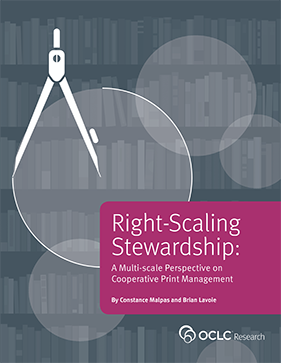Right-scaling Stewardship: A Multi-scale Perspective on Cooperative Print Management
#printscale
An OCLC Research Report by:
Constance Malpas and Brian Lavoie, OCLC Research
This report explores regional-scale cooperative print management from two perspectives: a local academic library print book collection (The Ohio State University), and a consortial-scale collective print book resource (the Committee on Institutional Cooperation, a consortium of major US research institutions).
Highlights
- Ohio State and CIC print book collections are a rich case study for examining local and consortial implications of shared print management.
- Scale impacts nearly all the fundamental characteristics of a collective print resource and the cooperation needed to sustain it.
- Scale adds scope and depth: aggregation quickly builds up the “long tail” of a collective print book resource.
- Scarcity is relative: distinctiveness of a print book resource not intrinsic to the resource itself, but depends on frame of reference.
- Coverage requires collaboration: shared print is a shared responsibility; no local or group-scale collection approximates complete coverage.
- Rareness is common: local and group-scale print book collections reflect heavier investment in rare compared to widely-held materials.
- Shared print strategy just as much about identifying distinctive local and group strengths as about consolidation and reducing redundancy.
- Shared print strategies likely to be formulated around redundant and distinctive materials; understanding their characteristics is key.
- Print retention decisions taken at the local and consortial level will impact the broader library system.
- The value of a collective print book resource can be enhanced through more effective strategies for disclosure and delivery.
Abstract
The goal of this report is to provide an empirically-based assessment, based on WorldCat bibliographic and holdings data, of the size, scope, and salient features of these collections, with special attention to identifying and characterizing segments consisting of relatively scarce and relatively widely-held materials. The analysis also employs a subject-based approach to identifying distinctive collecting strengths at both the local and consortial level, and examines network demand for the consortial print resource using WorldCat Resource Sharing inter-lending data. Insights and findings drawn from the analysis are discussed, which help map the territory of cooperative print strategies organized as a regionally-scaled collaboration. In particular, the findings highlight how scale shapes the scope and depth of the collective print resource; the degrees of redundancy and distinctiveness attached to that collective resource at both local and consortial level; and the scope of cooperation needed to achieve reasonable thresholds of coverage and access. The report also addresses how “right-scaling” stewardship of the collective print investment lies at the center of any shared print strategy, in the sense of determining which materials are best managed at the local level, which are best moved into some form of shared stewardship infrastructure, and the appropriate scale at which collective management should take place.
This work is an output of our activity, Right-scaling Stewardship: A System-wide Perspective on Print Books in the CIC which falls under our work agenda theme of Understanding the System-wide Library. It extends earlier work on regionally-based shared print collections reported in Print Management at "Mega-scale": A Regional Perspective on Print Book Collections in North America, available at: http://oclc.org/content/dam/research/publications/library/2012/2012-05.pdf.
This report will be of interest to libraries investigating or implementing shared, group-scale approaches to managing print book collections. The analysis and findings of the report will help to support a growing number of institutions that are broadening the scope of existing shared print programs from journals to monographic resources. While the case study focuses on research-intensive university libraries in the United States, the findings will be of interest to all libraries transitioning from operating models based on local collection management, toward models that leverage economies of scale.
Suggested citation:
Malpas, Constance and Brian Lavoie. 2014. Right-scaling Stewardship: A Multi-scale Perspective on Cooperative Print Management. Dublin, Ohio: OCLC Research. http://www.oclc.org/content/dam/research/publications/library/2014/oclcresearch-cooperative-print-management-2014.pdf.
